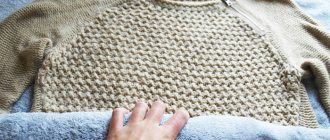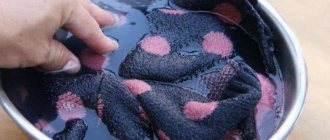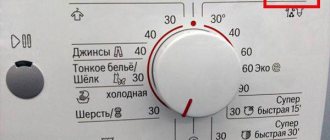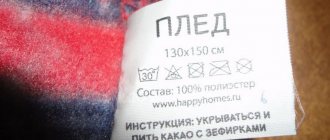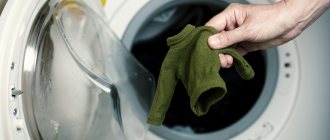Cotton is a fiber of plant origin. Due to its durability and low cost, it is in great demand.
However, it is important to handle it correctly. After all, like many other fabrics of natural origin, cotton (it is also called “cotton” in English) is prone to deformation when interacting with water and heating.
Does cotton shrink after washing and why does this happen, how to prevent shrinkage and correct the situation if the item does shrink? You will find answers to questions in the article.
Preparing cotton items for washing
If a large number of cotton items have accumulated in the basket, first of all, they need to be sorted.
First, you should separate white, colored and black laundry. You can’t wash it together, because as a result, white will at best become gray, and colored will change color.
Light-colored products are sorted in 2 stages:
- Separate laundry that only needs to be refreshed from heavily soiled and stained laundry.
- Based on the label, items made from mixed fibers, as well as delicate, terry, and lint items are put aside.
Colored models are classified according to composition and color strength. Black clothes are washed only with dark colored items.
New denim items, as well as coats and jackets, for example: diagonal, moleskin, corduroy, are cleaned by hand or in a washing machine only on an individual basis.
After sorting, the following manipulations are performed with things:
- Outerwear with zippers and buttons is fastened and turned inside out.
- Pillowcases and duvet covers are also turned inside out and loose fluff and dirt are removed from their seams.
- Dust is shaken out of velvet and velor jackets, covers, and curtains, as they tend to attract large quantities of it.
Variety of species
Cotton, what kind of material you can find out by looking at its main varieties - these are pure cotton fabrics: chintz, satin, poplin, flannel, calico, cambric, and fabrics with the addition of synthetic fibers. Combination with the listed types with various artificial threads gives completely new fabrics:
stretch – 5% addition of elastic fibers to cotton fabric. Provides a tight fit of clothing to the figure;
polycotton - cotton with the addition of 35% polyester. The material is used to make home textiles and bed linen. Artificial thread gives the fabric wrinkle-resistance, elasticity, and high wear resistance;
memory is a fabric with a smooth surface that remembers its shape well. Does not wrinkle, does not stretch, is easy to wash, dries quickly.
Cotton material description of fabrics that have an elegant shiny appearance:
satin is a dense material with a smooth surface on one side and matte on the other. Suits, trousers, skirts, dresses are made from it;
satin is a beautiful material with a shiny front side and a matte backside.
Interesting: Cotton is known to be equated with white gold. In India, there was a belief that cotton was given to them by the Gods. Therefore, merchants exchanged cotton fabrics for gold.
Soak
Heavily soiled cotton items require soaking before the main wash. For wardrobe items and curtains made of openwork and thin fabrics, it is better to choose a liquid or gel when soaking. After drying, they will not leave streaks on the surface.
White cotton models are pre-treated as follows:
- Things are immersed in clean water for 2-3 hours. Then they are wrung out. Soaking is carried out only at room temperature. Hot water will further embed dirt and possible stains into the fibers.
- Soda (table or soda ash) is dissolved in a glass of hot water and poured into a washing container (1-2 tablespoons of the substance are required for 10 liters of water). The laundry is kept in the solution for half an hour.
- Rub a quarter of a bar of laundry soap into a separate bowl or pour 2 tbsp. l. washing powder for white fabrics. The detergent is thoroughly diluted with hot water and added to the container with laundry. Things should remain in this composition for another 2-2.5 hours.
- The products are pressed again and a decision is made on their further processing.
For tulle and muslin curtains (with the exception of kitchen ones), this procedure is sufficient, and all that remains is to rinse them.
Socks are soaked separately from other items, having previously been rubbed on the inside with laundry soap. Used handkerchiefs and models with embroidery are also pre-washed in the container. They are soaked in a slightly warm saline solution (30 g per 1 liter), and then the main wash is done in it.
This may be useful: How to whiten socks.
Colored cotton clothes are soaked in warm water with a special detergent. You should not use laundry soap, as the alkali it contains can cause the fabric to fade. To prevent hardness salts from damaging the color, soften the water with baking soda or ammonia (1 tsp per 5 l). The soaking time for dyed fabric ranges from 15 to 30 minutes. The more a thing sheds, the shorter the time period should be .
It is not recommended to immerse knitted fabric and velvet in water for a long time. Therefore, such things do not need pre-washing at all.
When first processing chintz and denim, add 3 tbsp to the water. l. salt or 5-6 tbsp. l. 9% vinegar per 10 liters. This will minimize shedding if the jeans are dyed.
Features for various materials
The difficulty of washing knitted clothes is due to the need for delicate processing. All important factors must be taken into account:
- type of material;
- color and its durability;
- hand/machine knitting;
- quality of tailoring, etc.
Made from wool
Most sweaters, especially those made from wool and angora, should not be soaked for long periods of time.
This material is sensitive to high and low temperatures. High temperature causes the item to shrink . And it can seriously decrease in size.
Particular care should be taken with items that are hand-knitted. The texture of such a sweater is looser than that made by machine knitting.
With careless care, serious deformation, change in size, and even the appearance of the item may become so poor that it will no longer be possible to wear it. You cannot rub woolen fabric during washing - it will become rough and tough .
Read about proper washing of wool sweaters here.
Made from acrylic
Acrylic fabric is warm, although it has a synthetic composition. Soft and cozy, such sweaters are easier to wash when compared to woolen items. Acrylic also tolerates contact with water more easily, practically does not wrinkle and does not lose its shape.
If the item is worn out, it is possible to pre-soak it in a solution of liquid detergent (even liquid soap will do). After a quarter of an hour, the item is rinsed and washed in a machine or by hand.
The exception is chunky knit and handmade sweaters. The same rules that apply to woolen products must be applied to them.
Cotton
Sweaters knitted from cotton threads are hypoallergenic.
They do not irritate the skin and are able to retain heat. The peculiarity of such clothes is that during wear and after several washes, pills may appear on them .
The processing temperature is determined by the label. In principle, such yarn can withstand even temperatures above +30ºС. But for each thing this parameter is determined separately.
It is affected by:
- color fastness;
- texture of thread weave;
- looseness of knitting, etc.
Even for white cotton pullovers, you should not use chlorine detergent.
Cashmere
A soft and very comfortable cashmere sweater - warm and practical. You can wash such a thing, but not too often, preferably by hand, since washing in a machine and spinning even at low speeds can lead to stretching of the product and the formation of pills.
Stain removal and whitening
Before the main wash, stains are removed from cotton fabric and the lost whiteness is restored to light-colored items. This can be done using a universal ready-made stain remover or folk remedies, after preliminary testing them on an inconspicuous area of the item. The cleaning method in the second case depends on the color of the fabric and the type of contamination.
- Oil stains from colored surfaces are removed with gasoline, acetone or turpentine, as well as soap alcohol (a solution of soap in wine alcohol). Light-colored items are cleaned with a paste of gasoline and crushed chalk. It is applied to the stain in a thick layer, and after a few hours it is cleaned off. If the result is unsatisfactory, the procedure is repeated 2-3 times.
- Remove traces of sweat from painted canvases with an aqueous solution of ammonia and rock salt (1 tsp per 200 ml). White things are saved with peroxide mixed with water in a ratio of 1:10.
- Streaks from a felt-tip pen, marker or ballpoint pen from colored wardrobe items are washed off with denatured alcohol diluted with water 1:10, and from white ones - with a heated aqueous solution of citric acid (10 g per 200 ml).
- Traces of fruit juice are removed from white fabric with citric acid mixed with wine alcohol (1:10 ratio) or water, as is the case with felt-tip pen stains. Colored fabrics are treated with heated glycerin or its mixture with chicken yolk. The composition is applied to the area of contamination, and after a few hours it is cleaned off.
After using any of these products, the stain is treated with clean water locally, and then the cotton item is washed completely.
Gray or yellowed fabrics can be revived by soaking in industrial bleach or one of the following solutions:
- 2 tbsp. l. table salt per 10 liters of water;
- 1 tbsp. l. ammonia and 2 tbsp. l. 3% peroxide per 10 liters of water. Processing time – 15-30 minutes with occasional stirring.
If linen with a 100% cotton composition needs to be not only bleached, but also disinfected, use the boiling method for half an hour. In this case, you can add to the water:
- grated laundry soap and 1 tbsp. l. ammonia;
- 2 tbsp. l. salt and soda, as well as washing powder with a bleaching effect;
- 3 tbsp. l. washing powder and 2 tbsp. l. "Whiteness."
Dry cleaning
Dry cleaning of knitted clothes offers customers the use of modern biotechnologies and professional equipment from leading manufacturers.
It is necessary to seek the services of professionals in cases where:
- the sweater cannot be washed - there is information about this on the label;
- the item has many decorative elements;
- the material fades;
- there is a danger of ruining an expensive item due to lack of experience in complex washing and difficult drying.
Dry cleaning will also help in cases where you don’t have time to do the laundry yourself.
The price will depend on several factors:
- material of the thing;
- provision of additional services (stain removal, etc.);
- sweater model;
- the presence of inserts from other materials, fittings, etc.
You can find a suitable dry cleaner on the Internet. Most of them work with electronic applications and accept orders by phone.
Items from the client are picked up by the courier, so you don’t have to waste your time first delivering the item and then picking it up. The cost of dry cleaning services on average is from 600 rubles.
Handwash
Pre-treated bed linen and wardrobe items made from durable fabrics are usually finished off in the washing machine. But for delicate fabrics (cambric, guipure, taffeta), as well as highly shedding material, for example: chintz, only hand washing is recommended. Thin fabrics are manually processed as follows:
- Any 100% cotton, and especially delicate fabric, tends to shrink when exposed to high temperatures. Therefore, water is poured into the washing container no hotter than 40°.
- A detergent is diluted in a basin, the choice of which depends on the color of the product. To improve the quality of washing white clothes, oxygen bleach is added to it; for colored clothes, table salt is added.
- When washing delicate cotton, do not rub it too hard, otherwise the fabric will become thin and may tear. It is also prohibited to twist clean models during spinning.
- Cotton items are rinsed thoroughly, changing the water several times. During the final rinse of colored fabrics, dilute 9% vinegar in a basin (1 teaspoon per 10 liters) to refresh the color.
Corduroy is washed in a special way. Semi-velvet is not completely immersed in water, but is cleaned with a brush, laid out on a hard horizontal surface. After treatment, the detergent is removed with a sponge soaked in clean water.
How to wash cotton items by hand?
After the item has been in use for some time, you need to wash it by hand as follows.
- Fill a basin with warm water, the temperature of which does not exceed 40 degrees.
- Add a tablespoon of grated laundry soap and wait until the composition dissolves. You can also use a special product designed for natural fabrics.
- Soak clothes in soapy water for 10-15 minutes, and then wash as usual.
In the washing machine
Washing in an automatic machine will be successful if you follow these tips:
First of all, you need to decide at what temperature to wash a particular item. A corresponding mark on the label will help with this. If it is lost, you can navigate like this:
- Bed linen, blouses and shirts made of white satin, percale, poplin, calico are washed at temperatures from 60 to 90°. The more dirty the item is, the hotter the water should be.
- Tulle, mixed fabrics, for example: polycotton, terry items, brushed models, regardless of color, are cleaned at 40°.
- Colored cotton, depending on color fastness, can withstand heating in the range from 30 to 60°. In order not to make a mistake with the choice of temperature, you can test the strength of the dye. To do this, a piece of light cloth is moistened in a hot soapy solution and the material intended for cleaning is rubbed from the inside out. If spots appear on a light piece, select the minimum temperature.
If white items are slightly stained when a colored item of clothing accidentally gets into the drum, they are soaked in very hot water with the addition of soda for 12 hours. And then rinsed and washed again in the usual way.
Choosing a detergent. As with hand washing, cleaners are poured or poured into the machine’s ditch, depending on the color of the laundry. For white, additionally use bleach (not chlorine). For fabrics containing polyester, conditioner is required. For colored items, the latter can be replaced with 3-5 tbsp. l table vinegar.
The vast majority of natural fiber items are washed on the cotton or cotton express cycle. The exceptions are: denim, bike, frote (terry), flannel, veil. For them, select the “delicate wash” program and manually set the spin cycle to no more than 500 revolutions and additional rinse.
Automatic drying of cotton is undesirable, as it causes severe shrinkage. It is allowed to be used during the second and subsequent washes only for laundry that has a corresponding indication on the label.
You should not put natural fabric and synthetics into your car at the same time. Cotton items will become covered in pellets.
How to prevent things from shrinking
It seems that the pain of stretching a shrunken item is the best preventive lesson. But it’s better to have additional knowledge on how to make sure this doesn’t happen again.
- Make it a habit to examine the tags on items, especially those made from potentially delicate fabrics.
- Always wash in cool water. The fabric fibers will remain stronger and the item will last longer.
- When choosing a woolen new thing, buy the product one size larger.
- Do not leave the item near heating devices or in direct sunlight.
Perhaps the best way to prevent fabric shrinkage is to follow the instructions and be more careful about sorting your laundry before washing. However, now you have knowledge in your arsenal of what to do if such a situation does occur.
What to do if cotton shrinks or stretches
Will cotton shrink after washing and how much? Most fabrics made from its fibers shrink on average by 1-3% in width and 4-6% in length (the exceptions are sateen and polycotton).
The opposite problem can arise after immersing knitted fabric in water - it not only shrinks, but also stretches. Is it possible to return damaged items to their original size? It is impossible to give a definite positive answer to this question, but it’s worth a try.
If the item shrinks, proceed as follows:
- Soak for two hours in water with oxygen bleach or peroxide. In the process, they try to stretch the model. Then it is rinsed and dried in a horizontal position.
- The damp fabric is ironed with a hot iron in the “steaming” mode. In this case, the product gradually stretches in the desired direction.
You can try to save stretched knitted clothing using one of the following methods:
- Place the model in a basin of hot (temperature 60-80°) water and hold it there until you can put your hand in the water. Wring out the item and place it in a container with cold water. After 10-15 minutes, the knitwear is wrung out again and, without straightening, placed on a terry towel spread on a horizontal surface to dry.
- Let the knitwear sit in water with a softener, and then, lightly wringing it out, dry it in the drum of the machine at maximum temperature.
Please remember that only certain things can be increased. You can't do anything with most items of clothing (blouse, trousers or jeans). You don’t even have to try to restore a stretched model if it contains polyester.
Why do clothes shrink?
Wool, cotton, knitwear and silk are susceptible to shrinkage. In order to understand the problem and not make any more mistakes, you need to figure out why the item shrinks after washing.
- Water temperature. For example, on the tag of a dress made of woolen fabric you can see care instructions. Often the recommended water temperature is indicated there. Usually it is no higher than 30-35 degrees. After washing it in hot water, you can see that the dress has shrunk after washing. This happens because the fibers of the fabric change their structure. In the case of woolen items, if they shrink a lot, this indicates that they are made from really good natural threads.
- Incorrect spin mode. In this case, you should also not deviate from the manufacturer’s advice. If after washing the product shrinks, it means that the recommended regime was violated. Fixing this error is not easy. If clothing gradually shrinks under temperature differences, then mechanical stress only aggravates the situation.
- Features of the fabric. It is necessary to study the properties of the fabric more carefully. For example, silk items are most often subject to shrinkage.



